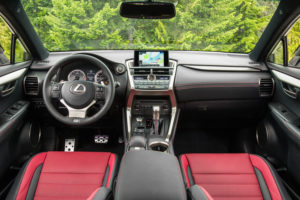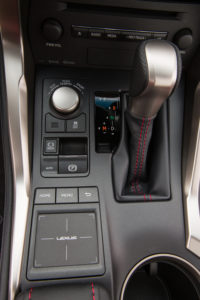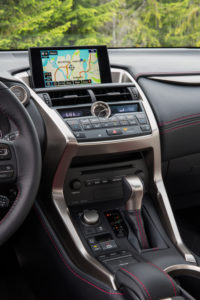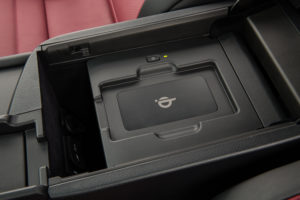Entry-level crossover SUVs seem to have infiltrated every mass-market automaker’s lineup. It’s easy to see why these oversized four-door hatchbacks have become so popular – more room than smaller cars, fewer trips to the pump than larger vehicles force upon you – what’s not to like?
And the segment is so competitive, it has given rise to hugely popular models. Into this arena comes the well-appointed 2017 Lexus NX 200T F SPORT.
First impressions
The 200 Net cuts a dashing figure in Atomic Silver. The operative word here is “cuts” since the body looks like it was designed to slice through the air and whatever else it touches. Sharp edges along the sides guide the eye front to back, making this crossover look a little more compact than it actually is, and sleeker than its size should allow.
Interior
F SPORT Black dominates a leather-lined interior accented by bits of carbon fibre. The overall look is luxurious without being ostentatious. Touches that never grow old include the white stitching on black leather and the analog LEXUS-branded clock in the middle of the dash that lights up tastefully at night.

image courtesy Lexus. (My tester had an all-black interior)
Taller rear-seat passengers (like yours truly) benefit from a ceiling that slopes up where the moonroof cavity ends. I found legroom to be sufficient, though one rear-seat passenger found the seats snug and didn’t like having to duck her head to enter the NX 200. To be fair, her daily driver is a minivan.
The F SPORT Series 3 trim, a $12,250 package on my tester, offers all sorts of in-cabin (and other) goodies. The leather-wrapped, button-bedecked steering wheel gains heating from about 8 o’clock to 10 o’clock and from 2 o’clock to 4 o’clock. In other words, the top and bottom of the wheel aren’t heated – only the parts where your hands ought to be get comfortable in cold weather.
Memory settings for three different drivers include the seat, steering wheel and auto-dimming power side mirrors.
Hockey bag test
The hatch accommodates my bag and little else. I had to shuffle my equipment a little so the bag wold sit flatter and not push up on the privacy cover.

The 60-40 split folding rear seats make more room, but this luggage area is at best par in the entry-level crossover class. Competitors like the Acura RDX and Honda CR-V offer positively cavernous hatches in comparison.
In-cabin technology
A laptop-like touchpad sits by the driver’s right leg. That touchpad, which Lexus calls Remote Touch, is what the driver and front-seat passenger use to control the Lexus Display Audio system.

image courtesy Lexus.
It works much like any touchpad, so anybody who has ever used a laptop ought to understand it immediately. Move your finger on the touchpad and a pointer on the screen moves with it. Press on the touchpad, and the pointer clicks whatever it’s on top of. Lexus thoughtfully added a pad on which the driver rests the heel of the hand while using the pad, thus encouraging ergonomically correct usage.
Lexus designed this system to minimize the amount of attention a driver has to use to work it. Anytime the pointer lands on something clickable:
- the item on the screen glows brighter.
- if audio feedback is engaged, a short “boing” sounds at the same time.
- the touchpad “jumps” a little under the finger, a feature known as haptic feedback.
Combined with the screen’s placement on top of the dashboard, drivers ought to be able to keep their eyes on the road ahead more of the time. This is a safety and ergonomics win.
I’ve heard criticisms of the screen’s placement. The look isn’t as aesthetically pleasing as it is when the screen is embedded in the centre stack. It looks like a tablet computer the driver could pick up and walk away with. But I’d say the safety benefits of having one’s eyes focused on the road ahead more of the time outweigh aesthetic concerns, and that’s a benefit of placing the touchscreen so high. Carmakers like Lexus, BMW and Mazda get this. I hope to see it from more manufacturers.

image courtesy Lexus.
The 10-speaker sound system (an F SPORT feature – the standard NX sound system ships with 8 speakers) is more than adequate. It let me both blast a workout playlist and quietly enjoy classical music.
Lexus put a heads-up display (HUD) system in the NX (more precisely, in the F SPORT package). A projector sunk into the dash between the wheel and the windshield projects information like speed, “eco-performance” and the next turn on a GPS-mapped route onto the windshield. The information appears to hover just above the edge of the NX’s front end.
Lexus, here’s a tall driver’s request – please let us place this information a few inches higher so we don’t need to drop our eyes at all from the road ahead.
While it makes sense to place the HUD controls out of the way (to the right of and behind the steering wheel in the NX), that makes them difficult to access when a different driver takes the wheel. The height of the HUD ought to be recorded in seat memory settings, along with side mirror, seat and steering wheel positions.
Charging mobile devices can be done by the usual ports, plus a wireless charging tray in the centre storage console.

image courtesy Lexus.
Here’s a neat convenience feature: taking the NX out of park automatically disengaged the parking brake, while putting it into park automatically engaged the brake. Score another point for sensible design.
Driving
A 2-litre turbocharged four-banger puts 235 hp down to all four wheels via a six-speed automatic transmission.
The F SPORT package adds paddle shifters. They’re responsive enough, but I can’t get enthused about paddle shifters in road vehicles any more. There’s no impetus to shift gears when automatic is just a move of the shift lever away. I keep wondering whether the novelty of paddle shifters in road cars will ever subside.
Drivers can experience the vehicle in Normal driving mode as well as Sport and Eco. Step on the gas in Eco, though, and the NX doesn’t ask twice – away you go. This isn’t a drag racer by any means, but the engine willingly spins up to north of 5,000 RPM to provide a few thrills to drivers who step on the gas.
On the highway, Dynamic Radar Cruise Control and Lane Departure Alert With Steering Assist help keep the NX safely away from other vehicles around it.
Active safety features come standard on the NX 200: Vehicle stability control, traction control, electronic brake force distribution and hill-start assist make the NX pretty stable in slippery conditions. Upgrade to F SPORT and you’ll get Blind Spot Monitor System, Clearance and Backup Sensors and Rear Cross Traffic Alert. All NXs ship with a plethora of passive safety features, including a front collision detection feature.
Fuel economy
Lexus publishes the following numbers: 10.6/8.4 (City/Hwy) and 10.8/8.8 (F SPORT ) (City/Hwy). The NX takes 91-grade fuel or better in its 60-litre tank.
Pricing
Base MSRP on the 2017 Lexus NX 200T is $42,750. With the F SPORT package, taxes and other fees, my tester came to $57,171.25.

10.6 is that miles per gallon
If so very poor milage
10.6 is L/100km. Not great mileage but about what you’d expect in a vehicle this size.